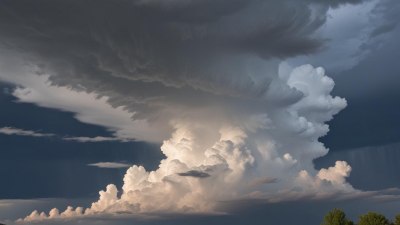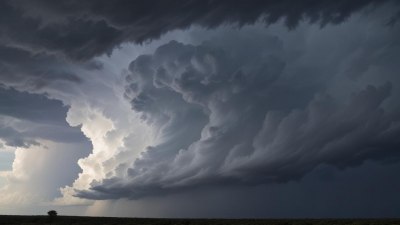What Causes Virga Clouds to Appear
Discover the science behind virga clouds and their fascinating formation processes.

This image was created with the assistance of Freepik
Virga clouds, with their unique and ethereal appearance, have captivated the attention of meteorologists and weather enthusiasts alike. These clouds, which appear to be shedding precipitation that evaporates before it reaches the ground, present a fascinating study in atmospheric science. Understanding the causes of virga clouds involves delving into several meteorological principles, such as humidity, temperature, and air pressure. This article will explore the formation of virga clouds, their characteristics, and the conditions that lead to their development.
What Are Virga Clouds?
Virga clouds are defined as streaks of precipitation that fall from clouds but evaporate before reaching the ground. This phenomenon is most noticeable when the precipitation falls as rain, sleet, or snow. What makes virga visually stunning is the contrast between the cloud's dense, precipitation-filled appearance and the dry air beneath it. When the moisture-laden air from the clouds descends through a drier atmosphere, the conditions are ripe for virga formation.
The Science Behind Virga Formation
The formation of virga clouds is primarily influenced by a few key meteorological factors. Firstly, the ambient air temperature plays a critical role. When the air at lower altitudes is significantly warmer than the air at cloud level, the moisture that falls from the cloud begins to evaporate before reaching the surface. As the raindrops or snowflakes descend, they encounter pockets of warm, dry air that sap their moisture content, creating the visible streaks of virga.
Humidity Levels
Humidity is another significant factor in virga formation. For virga to occur, the air below the clouds must be relatively dry. High humidity levels near the surface will allow precipitation to reach the ground, while low humidity levels will aid in the evaporation process. The drier the air, the more likely it is that falling precipitation will evaporate before making contact with the ground.
Temperature Inversions
Temperature inversions contribute to the occurrence of virga clouds as well. An inversion occurs when a layer of warmer air traps cooler air below it. This creates a stable atmosphere with distinct layers of temperature. When precipitation falls through this inversion, it may encounter the warm air that can cause the moisture to evaporate before it has a chance to reach the lower temperatures in the cool air beneath. This is a common scenario in regions with stable air masses, such as deserts or areas with persistent high pressure.
Types of Clouds Associated With Virga
Virga is commonly associated with specific types of clouds. Typically, it is observed in cumulonimbus clouds, which are tall, towering clouds that indicate convection and strong upward air movements. These clouds have the potential to produce heavy rain, thunderstorms, and severe weather. However, virga can also originate from other cloud types, such as nimbostratus and altostratus clouds, particularly where conditions permit moisture to evaporate during descent.
Visual Characteristics of Virga
Visually, virga clouds can appear as delicate, wispy tendrils extending downward from a cloud base. They may resemble light streaks or curtains of rain, often shimmering as they catch the sunlight. The beauty of virga clouds has made them a favorite subject for photographers and nature lovers alike. Observing virga can also serve as a valuable visual cue for forecasting weather changes, indicating shifts in humidity and temperature.
Weather Conditions Favoring Virga
Certain weather conditions can enhance the likelihood of observing virga clouds. For example, during hot summer afternoons, the intense heating of the Earth's surface can create strong updrafts that contribute to cloud formation higher in the atmosphere. If the upper levels of the atmosphere contain moisture but the surface remains dry, virga may develop. Conversely, during cooler months or in transitional seasons, virga can appear when moist air is forced upward in advancing cold fronts.
Practical Implications of Virga
While virga might seem innocuous at first glance, it does have practical implications for both weather prediction and aviation. For meteorologists, the presence of virga can signal specific atmospheric conditions that may precede larger weather systems. It can indicate the likelihood of thunderstorms developing later, especially if the virga is produced by towering cumulonimbus clouds. For aviators, observing virga can provide critical information on wind patterns and turbulence, particularly when flying in or near convective activity.
Virga in Different Regions
Virga is often more prevalent in certain geographic regions and climatic conditions. In arid and semi-arid environments, such as the western United States or parts of Australia, virga occurs frequently due to overall low humidity levels. Virgin and humid conditions, on the other hand, can limit the formation of virga. Understanding these regional distinctions helps meteorologists and researchers study weather patterns and predict local weather conditions more accurately.
The Importance of Research
Research on virga clouds plays a crucial role in advancing our understanding of precipitation processes and atmospheric dynamics. By studying virga, scientists can gain insights into cloud microphysics, the behavior of moisture in the atmosphere, and the effects of various meteorological conditions on precipitation. Additionally, research on virga can enhance weather modeling, leading to improved forecasting practices.
Notable Observations of Virga
Throughout history, virga clouds have been observed and documented across the globe. In the deserts of the southwestern United States, virga frequently appears during monsoon season, leading some to refer to it as “ghost rain” due to its ephemeral nature. Similarly, in regions of Southeast Asia, virga can occur during the wet season as moist air interacts with local topography, creating localized rainfall patterns that do not reach the ground.
The Future of Virga Research
The future of virga research holds promise as advancements in technology and data collection enhance our ability to study clouds. With the proliferation of satellite technology and ground-based observation networks, researchers can gather more accurate atmospheric data and better understand the conditions leading to virga formation. This ongoing research will contribute not only to fine-tuning atmospheric models but also to understanding the broader implications of precipitation and climate change.
In conclusion, virga clouds present a captivating intersection of meteorology and atmospheric science. Their unique formation processes and distinctive appearance illustrate the complexities of weather phenomena. Understanding the causes of virga involves examining factors such as humidity, temperature variations, and air pressure patterns. As research continues to unravel the intricacies of virga, we can appreciate its beauty while gaining valuable insights into the dynamic nature of our atmosphere.











